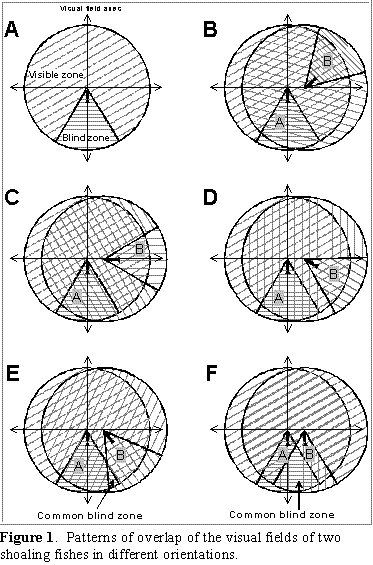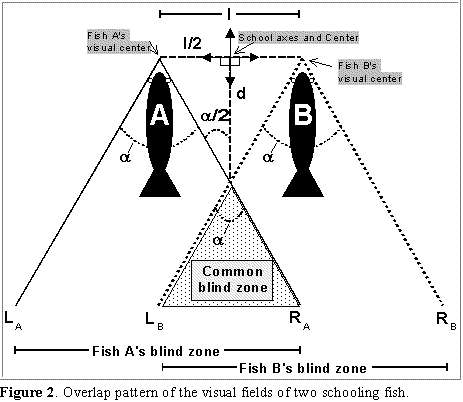Navigate toolbar: [ Diets | Photos | Estuarine | FADs | Soniferous | CV | Home Page ]
Rountree, R.A. and G.R. Sedberry. 1998. A preliminary model of shoaling behavior based on visual field overlap patterns. Pages 57-60 IN: MacKinlay, D.D., and D. Houlihan. (eds.). Fish Feeding Ecology and Digestion: Gutshop '98. International Congress on the Biology of Fish, Towson University, Baltimore MD, July 27-30, 1998. Physiology Section, American Fisheries Society. Don MacKinlay, SEP DFO, 555 West Hastings St. Vancouver BC V6B 5G3, Canada. (Extended Abstract).
A PRELIMINARY MODEL OF SHOALING BEHAVIOR BASED ON VISUAL FIELD OVERLAP PATTERNS
Rodney A. Rountree
University of Massachusetts at Amherst
and
George R. Sedberry
South Carolina Marine Resources Research Center
Abstract
We propose a hypothetical visual-field-overlap (VFO) model for shoaling behavior. Although it has long been known that animals can not see equally well in all directions, and that they have a complex visual field which has important implications for predator-prey interactions, the characteristics of the visual field have only been measured for a few species of fish (Walls, 1942). The importance of visual field characteristics other than the range of visibility have generally not been considered in studies of animal grouping behaviors such as flocking and shoaling, which implicitly assume equal vision in all directions. The purpose of this paper, therefore, is to present a theoretical exploration of how characteristics of a fish's visual field can be used to model some aspects of shoaling behavior.
Solitary fish have the disadvantage of a substantial blind zone to their rear, typically of 20-60 (Fig. 1a). When two fish associate in a shoal, their visual fields overlap in such a way as to impart to them a distinct advantage over solitary fish (Fig. 1b-f). Figure 1b-f illustrates how the visual field of a second fish (fish B) would overlap with the first (fish A) under different conditions. In each case, fish B is located the same horizontal distance to the right of fish A, but its visual axes is rotated at various angles relative to the visual axes of fish A. In the first example, fish B is rotated more than 90 counter-clockwise to fish A (Fig. 1b). In this shoal configuration each fish can see most of the other fish's blind zone within its limit of vision, except for small shadow areas caused

by the opposite fish's body (not shown). An approaching predator would, therefore, be visible to at least one of the fish regardless of which direction it came from (although whether or not either fish actually detects the predator in its field of view is dependent on other factors). Similar patterns are observed when fish B is rotated 90, and when rotated at an angle equivalent to the blind angle (Fig. 1c and 1d,respectively). When fish B is rotated at an angle less than the blind angle (a), however, the blind zones of the two fish intersect so that there is a blind zone common to both fish (Fig. 1e). The location and configuration of this common blind zone is dependent on the blind angle (a), distance between the fish, angle of rotation relative to the visual field axes of a reference fish, and the range of visibility. When both fish are parallel (i.e., highly oriented into a polar school formation), this common blind zone is maximized (Fig. 1f). These observations suggest that although any shoal of two or more fishes would have a distinct visual advantage over a solitary fish, highly polarized shoals (schools) have a distinct disadvantage relative to non-polar shoals in that a predator could approach from behind the school for some distance without detection.

However, in situations where fishes must orient in one direction, the visual fields of individuals in the school overlap such that the common blind zone is considerably farther down current than the blind zone of any particular fish. The overlapping visual fields of two schooling fish are illustrated in Figure2. For simplicity, only the blind zones are illustrated, and the effects of the range of visibility are ignored. The horizontal distance between the two fish is defined as the interfish spacing (I). School width (w) is equal to I, or (N-1)I for a school of 2 and N fish, respectively. The distance to the school's common blind zone (d) is measured from the horizontal axis to the intersection of the interior lines of sight (here LB and RA) of the two most lateral fish. A simple geometric relationship between school width, the blind angle, and the distance to the common blind zone, predicts that larger schools can detect predators at a greater distance than smaller schools. There would also be a tendency to increase interfish spacing in order to push back the common blind zone, which would be counterbalanced by advantages gained by the increased overlap of visible fields among fish with decreasing interfish spacing.
Additionally, the model provides a novel explanation for the nearly universally observed tendency for fish to school together with like-sized individuals. It predicts that fish should avoid joining schools of larger individuals, but a selfish large fish might profit from joining a school of smaller fish. However, odd sized fish can compensate by increasing interfish spacing to their neighbors. Finally, the effect of school shape on the visual field overlap pattern would have a strong impact on predator-prey interactions. The VFO model suggests that schooling in planktivores is an adaptation to enhance feeding efficiency by reducing the need for individual vigilant behavior while feeding in the water column. We believe the VFO model promises to provide considerable insight into the behavioral ecology of shoaling fishes, and that it is highly amenable to both field and laboratory testing.
References
Walls, G.L. 1942. The vertebrate eye and its adaptive radiation. Bull. of the Cranbrook Institute of Science 19:375-376.
This page was last modified on July 20, 2001
Copyright © 1999 by Rodney Rountree. All rights reserved
Navigate to abstract pages: [ Parent | deeganabs | mastabs | bms89 | ebf90 | disabs | est92 | tafs92 | copeia92 | ecss93 | ices93 | fishb96 | escs97 | meps2000 | schext ]
Navigate to main pages: [ Diets | Photos | Estuarine | FADs | Soniferous | CV | Home Page ]